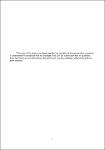Gender and literary form at the edge of the Arthurian world: Richard Johnson's Tom a Lincoln and William Rowley's The Birth of Merlin re-examined
| dc.contributor.supervisor | Moore, Dafydd | |
| dc.contributor.author | Boone, Emilia | |
| dc.contributor.other | School of Society and Culture | en_US |
| dc.date.accessioned | 2023-06-23T10:12:48Z | |
| dc.date.available | 2023-06-23T10:12:48Z | |
| dc.date.issued | 2023 | |
| dc.identifier | 10632301 | en_US |
| dc.identifier.uri | https://pearl.plymouth.ac.uk/handle/10026.1/20997 | |
| dc.description.abstract |
In its close examination of Richard Johnson's popular prose romance Tom a Lincoln, published in two parts in 1599 and 1607, and William Rowley's play The Birth of Merlin or the Childe Hath Found His Father, first performed in 1622, this project aims to explore two key texts which have been previously neglected in discussions of Arthurian and early modern canons. It explores the intersection between canon formation, textual form, and gender to argue that to expand the Arthurian canon is to expand the possibilities critical examination within it. Examining practices of testimonials, language, ventriloquism, and adaptation, this project probes the tensions between the Arthurian canon and early modern literary tradition and how each engages with issues of gender to argue for the inclusion of these two popular texts into the Arthurian canon. Through comparison to both traditional Arthurian texts and the works of Johnson and Rowley’s contemporaries, this project argues that the understanding of the Arthurian canon, particularly as a part of a longstanding literary tradition, and its representation of gender necessarily shifts when these two texts are taken into consideration. Johnson and Rowley’s texts give voices to those who largely remain voiceless in the traditional canon, such as single mothers and victims of sexual violence, and as many of these elements clearly intersect with the form of the work, to dismiss these texts is to dismiss the contributions of the culture of popular media. Therefore, in its exploration of gender roles, this project demonstrates the dangers of potentially reductive arguments which focus solely on literary or historicist analysis of texts by examining the interplay between literature and cultural expectations inherent in the formation of a literary tradition. | en_US |
| dc.language.iso | en | |
| dc.publisher | University of Plymouth | |
| dc.rights | Attribution-NoDerivs 3.0 United States | * |
| dc.rights.uri | http://creativecommons.org/licenses/by-nd/3.0/us/ | * |
| dc.subject.classification | PhD | en_US |
| dc.title | Gender and literary form at the edge of the Arthurian world: Richard Johnson's Tom a Lincoln and William Rowley's The Birth of Merlin re-examined | en_US |
| dc.type | Thesis | |
| plymouth.version | publishable | en_US |
| dc.identifier.doi | http://dx.doi.org/10.24382/5052 | |
| dc.identifier.doi | http://dx.doi.org/10.24382/5052 | |
| dc.rights.embargoperiod | No embargo | en_US |
| dc.type.qualification | Doctorate | en_US |
| rioxxterms.version | NA | |
| plymouth.orcid.id | 0009-0005-9261-9162 | en_US |
Files in this item
This item appears in the following Collection(s)
-
01 Research Theses Main Collection
Research Theses Main



